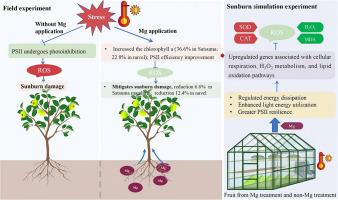镁通过提高光合效率和抗氧化防御来减轻柑橘类水果的晒伤损害
IF 4.2
2区 农林科学
Q1 HORTICULTURE
引用次数: 0
摘要
在气候变化的驱动下,气温升高和强烈的阳光事件加剧了柑橘晒伤,导致严重的果实损害和品质损失。镁(Mg)是叶绿素在光能利用中的关键成分,在柑橘类水果中减轻晒伤的作用尚未得到充分研究。本研究通过田间试验和模拟晒伤条件,研究了Mg处理对柑桔果皮晒伤发生率、损伤严重程度、光系统II (PSII)完整性和氧化应激的影响。田间试验表明,与未处理的树木相比,施用150 g MgO树- 1的萨橘和200 g MgO树- 1的脐橙分别减少了6.6%和12.4%的晒伤发生率。收集这些处理和对照组(0 g MgO树−1)的果实进行模拟晒伤实验。与未经处理的果实相比,施用Mg (150 g MgO树−1)显著提高了柑橘黄酮叶绿素含量36.6%和脐橙22.8%。田间和对照试验一致表明,添加Mg显著降低了过氧化氢(H2O2)和丙二醛(MDA)浓度,提高了抗氧化酶活性,包括超氧化物歧化酶(SOD)、过氧化物酶(POD)和过氧化氢酶(CAT)。此外,Mg处理改善了光合性能,调节了能量耗散,提高了光能利用率,增强了PSII在强光胁迫下的抗逆性。转录组学分析显示,Mg的应用上调了与细胞呼吸、H2O2代谢和脂质氧化途径相关的基因。这些发现强调了Mg在增强抗氧化酶和提高光合效率,从而减轻晒伤条件下的氧化损伤和脂质过氧化的作用。研究结果为在高温强日照条件下施用镁肥减少晒伤相关损害和提高柑橘果实品质的潜力提供了有价值的见解。本文章由计算机程序翻译,如有差异,请以英文原文为准。

Magnesium application mitigates sunburn damage in citrus fruits by enhancing photosynthetic efficiency and antioxidant defense
The increasing temperature and intense sunlight events, driven by climate change, have exacerbated citrus sunburn, leading to significant fruit damage and quality loss. Magnesium (Mg), a crucial component of chlorophyll in light energy utilization, has a largely unexplored role in mitigating sunburn in citrus fruits. This study investigated the effects of Mg treatments on sunburn incidence, damage severity, photosystem II (PSII) integrity, and oxidative stress in citrus peel, using Satsuma mandarins and navel orange in both field trials and simulated sunburn conditions. Field trial indicated that Mg applications at 150 g MgO tree−1 for Satsuma mandarins and 200 g MgO tree−1 for navel oranges reduced sunburn incidence by 6.6% and 12.4%, respectively, compared to untreated trees. Fruits from these treatments and a control group (0 g MgO tree−1) were collected for simulated sunburn experiments. Mg fertilization (150 g MgO tree−1) significantly increased chlorophyll content in the flavedo by 36.6% in Satsuma mandarins and 22.8% in navel oranges compared to untreated fruits. Both field and controlled experiments consistently showed that Mg supplementation significantly decreased hydrogen peroxide (H2O2) and malondialdehyde (MDA) concentrations while enhancing antioxidant enzyme activities, including superoxide dismutase (SOD), peroxidase (POD), and catalase (CAT). Additionally, Mg treatments improved photosynthetic performance, regulated energy dissipation, and enhanced light energy utilization, contributing to greater PSII resilience under high light stress. Transcriptomic analysis revealed that Mg applications upregulated genes associated with cellular respiration, H2O2 metabolism, and lipid oxidation pathways in Satsuma mandarin flavedo. These findings highlight the role of Mg in strengthening the antioxidant enzymes and improving photosynthetic efficiency, thereby mitigating oxidative damage and lipid peroxidation under sunburn conditions. The results provide valuable insights into the potential of Mg fertilization as a strategy to reduce sunburn related damage and enhance citrus fruit quality in regions prone to high temperature and intense sunlight.
求助全文
通过发布文献求助,成功后即可免费获取论文全文。
去求助
来源期刊

Scientia Horticulturae
农林科学-园艺
CiteScore
8.60
自引率
4.70%
发文量
796
审稿时长
47 days
期刊介绍:
Scientia Horticulturae is an international journal publishing research related to horticultural crops. Articles in the journal deal with open or protected production of vegetables, fruits, edible fungi and ornamentals under temperate, subtropical and tropical conditions. Papers in related areas (biochemistry, micropropagation, soil science, plant breeding, plant physiology, phytopathology, etc.) are considered, if they contain information of direct significance to horticulture. Papers on the technical aspects of horticulture (engineering, crop processing, storage, transport etc.) are accepted for publication only if they relate directly to the living product. In the case of plantation crops, those yielding a product that may be used fresh (e.g. tropical vegetables, citrus, bananas, and other fruits) will be considered, while those papers describing the processing of the product (e.g. rubber, tobacco, and quinine) will not. The scope of the journal includes all horticultural crops but does not include speciality crops such as, medicinal crops or forestry crops, such as bamboo. Basic molecular studies without any direct application in horticulture will not be considered for this journal.
 求助内容:
求助内容: 应助结果提醒方式:
应助结果提醒方式:


